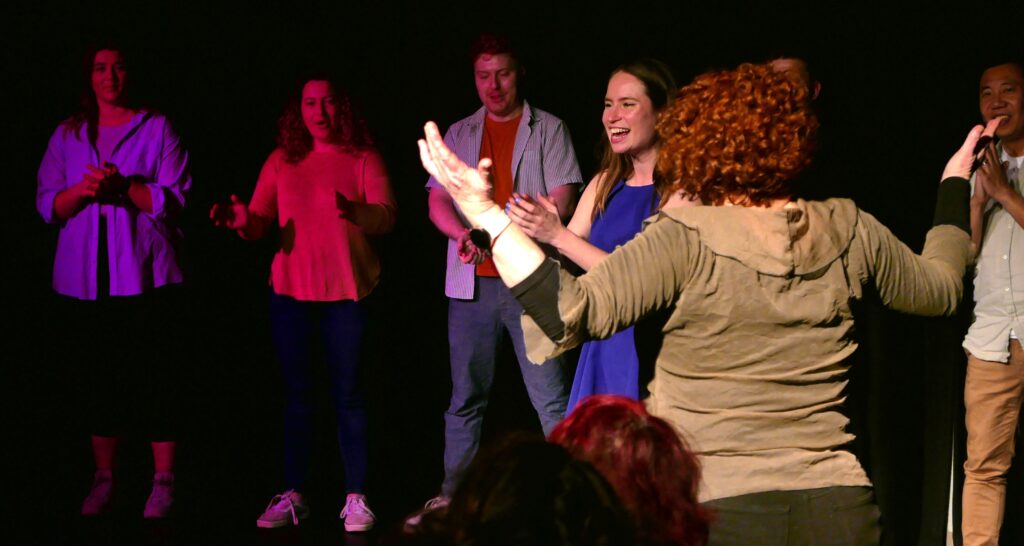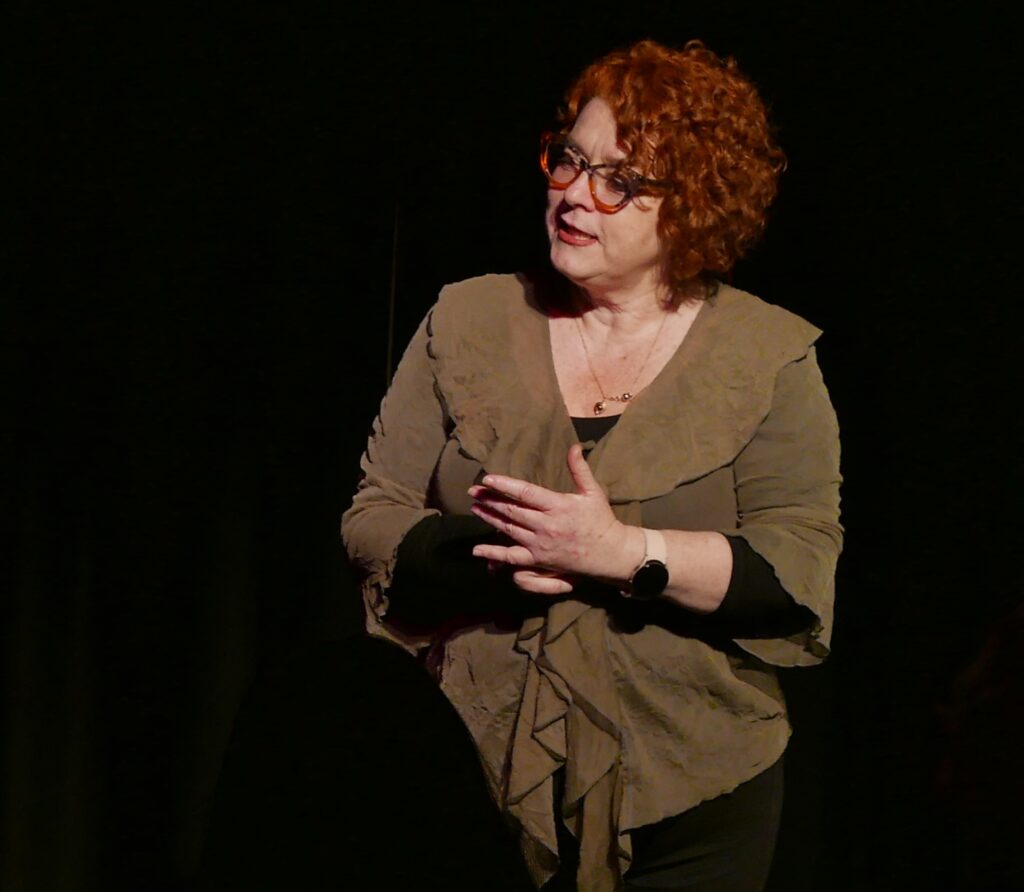I spent some time last night putting together a flowchart for identifying what kind of scene you are playing, because it’s quite a simple decision-making process but it’s masked with complexity.
i’ll have to verify it with miles today, and then i’ll make it pretty and add it onto this blog when i get a chance.
| NYPD tower at times square – resembles those big walking things in star wars |
this afternoon was deconstruction.
these are notes from days 2, 3 and 4
here is the basic template (again, i think a diagram would be better, i’ll get to it).
for a 25 minute deconstruction these are the timings (there’s no earthly reason it has to stay at 25 minutes, it’s just what we have this week to “graduate”).
- opening / foundation scene 6 minutes – should have a clear issue (and it helps if this is high stakes)
- 2 x theme scenes (which highlight the “deal” with the 2 characters in the foundation scene) 1 minute ish
- foundation scene (and characters play up their “deal” as highlighted) 2 minutes
- 5 commentary scenes x 1 minute
- foundation scene 1 minute
- run: 8 minutes total – starting at 40 seconds, and later scenes can be less than 3 seconds: all things are fair game, but scenes get shorter and shorter (in a crescendo, when it spirals out of control and finishes in the:
- final foundation scene resolving the “issue” 1 minute (may involve a time jump forward or backward)
characteristics of the opening scene
| roxy deli, times square, NY |
- 2 players only
- use all scene tools, but no walk ons, cut-tos, phone calls or time jumps (i.e. it’s just these 2 on stage in a realistic scene)
- conversation, add references (to books, movies, authors), details, characters you care about. don’t reference comedies (miles says the audience then compares you to the comedy – hey, they said seinfeld, that’s funny, this isn’t as funny as that – since opening scene isn’t comedic, it will never be as funny)
- when you hear the offer, think what relationship does that make me think of, and what’s the basic problem in this relationship
- don’t argue about the problem, but do talk about it a little – touch on it, and move away and then back again
- give realistic explanations for the behaviours
- must have a basic problem between you, something happening now
- talk about the problem then go off on a tangent (did you see the game last night, did you see batman), then come back. the wider you range in topics, the better it is for the deconstruction itself
- different levels of emotions, range of emotions and topics
- make them real and a little bit awful – fairly realistic, but not absolute realism: absolute realism is boring
- lots of references to culture (movies, books, plays, pop culture)
- if you mention people, name them if you mention a restaurant, name it
- make me worry a little about are they going to make it, we want audience to be concerned / invested in the relationship
- in our experience, scenes between brothers don’t seem to be high enough stakes (maybe this is about status). we had success with lovers/partners, parents / grandparents and children. we didn’t actually try any sister scenes, so i’m not sure whether it’s a status thing or an emotional investment thing
characteristics of the theme pulls
| abacus and mah jong inspired decoration at ruby foo’s, times square chinese restaurant |
- choose one theme for each character in the foundation scene: say optimism for one, pessimism for the other, but they do not have to be complementary, they do need to be different from each other
- scene essentially is a double absurd scene. first person states quite baldly the theme (I think everything’s bad) and the other mirrors and echoes and heightens (yes, everything is bad, I hate the world)
- scene is short
- keep it simple (if the theme is too long e.g. “not being able to do what she wants to do because” it’s not a theme). Themes are short and always in the positive e.g. I’m jealous, i feel betrayed, I’m hopeful, not “i’m not happy” but “i’m sad” not “i’m not loyal” but “i’m treacherous” – no qualifier on the theme – if there’s a qualifier then it’s commentary
- themes are the driving force behind what’s screwed up between the 2 of them
2nd foundation scene
- same 2 original players come out and continue their scene (maybe with a small time jump, but nothing too much) in the same place it was originally
- this time they play up their theme from the theme pulls, so that you really see their theme in them
- because they are playing up the themes, they will exaggerate, and reveal more flaws, which will be useful in the commentary scenes, and later in tangents
- in our experience, during the theme was an opportunity for the other players to remind the people in the opening scene if they forgot to name other characters who we can see later in the run, or to make any cultural refs
- 2nd (and 3rd) foundation scene in the same place as the first
- don’t resolve anything in the foundation scene until the closing scene
characteristics of commentary scenes
| in case you want a 2nd one… |
- the commentary essentially points out what’s screwed up about the way the people were thinking or interacting: e.g. he said he could never have a good time without alcohol, that’s screwed up
- the 2 people in the commentary scene essentially match and mirror each other, yes anding the initial idea (I like control, yes, I do too (and maybe an example of how they like control).
- the “math” for thinking this through: the character said he needed alcohol to have a good time translates to “who shouldn’t need something to do what”; e.g. a bride shouldn’t need a gigolo on her wedding night t to have a good time (so you play the gigolo/bride scene)
- stakes of the commentary scene must be higher than the original scene. if that’s not possible then either make them ridiculously low (you get jellybean for changing the world), or reverse the idea (instead of who shouldn’t need x to do y, try who should need x to do y, but doesn’t)
- if the set up isn’t completely clear, drag in the line or the emotion they used to make it clear
- examples: he blamed her for her mother’s death; who should not blame whom for what (or who should blame whom for what, but doesn’t). giving him a hard time for having a job; who should not give someone a hard time about what; who shouldn’t give someone a hard time but doesn’t
- all commentary scenes are straight/absurd (so figure which one you are by the opening line and then stick with it) – it’s got to have the straight guy to make it work (and all they do is heighten)
- 5 commentary scenes in a row
- make sure you heighten if you are the straight (do you like my kiss make up? you can’t wear that to church – gives context)
- litmus test on the commentary is whether i know what you’re commenting on
- normally opening scene characters don’t play in the commentary
| ever descending escalator, NY subway |
characteristics of the 3rd foundation scene
- again in the same place as the other 2 foundation scene
- essentially the first scene in the run, so needs to be long enough to set the pace at the beginning
- can have a small time jump, but not much
- we often started the run by a story line character tagging in to begin the next scene
characteristics of a run
- at the beginning scenes are longer – 1 – 1.5 minutes, and they get progressively shorter until it gets hectic and ‘out of control”, so much that people are talking over each other: emphasise speed in the way you move onto stage – getting faster
- opening scene characters can be used in the run (especially with story line characters)
- feel free to let the ideas “infect” the other scenes – e.g. if they refer to dickens, perhaps a dickens character somehow interacts with them or the other story line characters)
- open with the other characters (storyline characters) mentioned in the foundation scene (the husband, wife, kids, neighbours)
- if it’s just something that catches your ear, that’s a tangent
- father hits son with a bottle of budweiser: abuse is the theme, hitting someone is a commentary, budweiser is a tangent
- high energy group scenes work well for the fun (riot)
characteristics of a final foundation scene
- same 2 characters all the way through (maybe a 3rd at the end if it’s really necessary)
- could involve a time jump – forward to when the issue resolved, or if it’s not really soluble, backward to when the issue didn’t exist
- gives the audience a satisfying “the story is over” feeling
- if there is a recurring ‘bit’ in the run, then you can bring it into the final scene (e.g. vampire bite)
| rockefeller center decoration through my kaleidoscope lense |
general ideas:
- miles asks for a line of poetry from the audience as a suggestion (first thought should be what relationship does this suggest to me)
- this was created to see how many ways you can be inspired by a scene
- if you play it a lot you can relax a little around the form
- if you want someone to care about you, tell them about you
- if you know what a player wants, give that to them, before you do the “math” on who you should be in the scene
- big 5 themes for great art (good things to pick as your issue in foundation scene): mortality, sex, philosophy, religion, social structures
- by definition, great art lasts, so improv can’t do it, but it can tend towards great art
- roommate scenes don’t bring a lot of baggage, but parent/child, long term partners brings a lot with it – if you choose roommates as your relationship there are too many things to define, and strangers are even worse – never do a stranger or transaction scene as an opening
- miles doesn’t warm up (he says high energy is a decision: is warm up really just about energy??). he says if the group wants to warm up then he warms up (because that’s what you do)
- every format is a net to fall back on
- miles taught us the weave edit: AB are in a scene. C starts object work downstage in vision of B. B then crosses stage in front of A and engages in the scene with C. Meanwhile A goes to the other side of the stage and engages in object work in vision of C, and when it’s time C crosses the stage and engages with A. it’s called a weave because of the way the players move. it’s similar to a sliding door, and can go on indefinitely.




